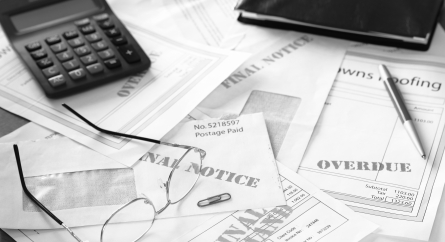Client Alert: Getting Paid in Bankruptcy – Part III, Landlords, Leases, and Licenses
In this series, we look at how various payment rights are treated in bankruptcy. A summary like this could not possibly address every right that might arise in any given bankruptcy case. We have omitted several of the Bankruptcy Code’s more esoteric legal protections and exceptions that arise in specific kinds of bankruptcy cases. When bankruptcy strikes, creditors should always consult a bankruptcy lawyer to understand what actions they need to take to preserve their rights and maximize their recovery.
The Basic Concept of a “Claim”
The Bankruptcy Code defines a “claim” to include any right to payment against the bankrupt entity (called the “Debtor”), regardless of whether the claim is reduced to judgment, liquidated, unliquidated, fixed, contingent, matured, unmatured, disputed, undisputed, legal, equitable, secured, or unsecured. It’s a broad definition.
Claims break down into four basic categories: (1) secured claims (“secured” because the Debtor has pledged property if it fails to repay the debt); (2) administrative expense claims; (3) priority claims; and (4) general unsecured claims.
It is no surprise that in bankruptcy there is seldom enough money to pay every creditor in full. Order of priority, therefore, is critical. Imagine the creditors forming a line: secured claims, followed by administrative expense claims, priority claims, and general unsecured claims. Equity claims – the owners’ stake in the Debtor – are technically at the end of this line, but since the estate is usually insolvent, they do not receive any payment at all.
Outside of bankruptcy, the creditor probably thinks about the money that the Debtor owes as a single debt. As we shall see, however, the Bankruptcy Code’s payment hierarchy can slice and dice this debt into several tranches according to what portions of the debt qualify as administrative expense, priority, or general unsecured claims. Creditors need to think about the money they are owed according to these claims, which can differ in value significantly. A $100,000 administrative expense claim could be worth far more in real dollars than an $1 million general unsecured claim, for example, and consequently worth investing more resources pursuing.
Creditors assert priority and general unsecured claims by filing a short and simple form with the bankruptcy court called a proof of claim. This can be done for little cost. If no one objects to the proof of claim, the claim is allowed. Administrative expense claims require a more extensive application filed through counsel. The bankruptcy court must approve the application before an administrative expense claim is allowed.
In a successful reorganization, administrative expense claims and priority claims are paid in full, while general unsecured claims can receive as little as nothing or as much as 100% plus accrued interest if the estate ends up being solvent. In most cases, the dividend on general unsecured claims is very small.
If the creditor owes the Debtor property (including money), it cannot receive payment until it has turned such property over to the Debtor. This allows the Debtor to net out liabilities as part of the claim administration process.
Claims for Rents
The Debtor may lease various kinds of tangible and intangible property giving rise to rent obligations. If a Debtor-renter wants to continue using the property after filing for bankruptcy, it must assume the agreement, cure the monetary defaults thereunder, and continue to perform under the terms of the agreement.
With limited exceptions, the Debtor will be able to assign its rights in the leased property to a third party who agrees to assume the Debtor’s performance obligations under the agreement. Alternatively, the Debtor can shed burdensome rent obligations by rejecting the agreement and returning the property. Lease rejection is treated as a pre-bankruptcy breach and the lessor’s rejection damages are treated as a general unsecured claim.
While all leases will either be assumed or rejected, the Debtor usually has several months to decide what to do. Pending the Debtor’s decision to assume or reject a lease, the lessor is prohibited from recovering the leased property. In the interim, however, the lessor is not obligated to provide services or supplies incidental to the lease without receiving compensation pursuant to the lease terms.
-
Landlords and Real Property Leases
Landlords have claims against debtor-tenants for rent, and other costs and expenses associated with the lease of real property. The Bankruptcy Code overrides provisions that automatically terminate the lease upon a bankruptcy filing, and the Debtor has several months to decide whether to stay in the lease or walk away. If the Debtor stays, it must cure outstanding defaults or offer “adequate assurance” that it will promptly cure them. If the Debtor rejects the lease and vacates the premises, the landlord will have a breach of contract claim, which is treated as follows: (1) assuming the estate is solvent, the landlord will be compensated for the post-petition use of the premises, which typically equals the contractual rent that has accrued post-petition, and (2) the landlord will have a statutorily-capped damages claim for the remaining rent due under the lease, which will be paid as a general unsecured claim.
The Debtor has broad latitude to assign its leasehold interest to a third party provided rent arrears are cured and the landlord receives adequate assurance of the new tenant’s ability to perform. With limited exceptions, landlords cannot block a proposed lease assignment.
For a more extensive look at landlord and tenant rights in bankruptcy, including special Bankruptcy Code provisions related to shopping centers, please read the alert Paying the Rent in Bankruptcy.
-
Personal Property Leases
The Debtor has a 60-day grace period after filing bankruptcy, during which it can retain leased personal property without making any payments. Thereafter, until the Debtor assumes or rejects the lease, it must resume performance. The Debtor may not assume or assign a lease if “applicable law” excuses the counterparty from accepting performance from or rendering performance to anyone other than the Debtor and the counterparty does not consent to the assumption or assignment. “Applicable law” refers to laws or regulations. It does not include an anti-assignment clause in the agreement itself. As explained above, the Bankruptcy Code abrogates such clauses.
If you lease an aircraft or registered vessel to the Debtor, you have an absolute right to reclaim the property, unless the Debtor quickly agrees to cure the default under the lease and resume all performance obligations. The Debtor has 60 days to obtain court authorization to continue performing and, if it fails to do so, the lessor may recover the property.
-
Intellectual Property Licenses
If you license intellectual property to the Debtor, the Debtor may assume or reject the license during the bankruptcy case. If the license is non-exclusive, the Debtor must obtain your consent to assign the license to a third-party. It should be noted that some bankruptcy courts view an exclusive intellectual property license as tantamount to ownership. Meaning, that the Debtor can assign the license without your consent.
If you license intellectual property from the Debtor and the Debtor rejects the license, you may continue to use the intellectual property. If you elect to do so, you must pay the contractual royalties to the Debtor-licensor. The Debtor will not have to perform under the license agreement, however. For this reason, it is particularly important for licensees of software to understand what rights they might have to the source code if the Debtor-licensor stops supporting the license.
-
Equipment Leases
If you leased equipment to the Debtor, it might be vulnerable recharacterization as secured loan rather than “true lease.” The distinction can have serious consequences. If the bankruptcy court decides the agreement is true lease, then you are entitled to have the lease assumed (in which case you receive everything you are owed) or rejected (in which case you get the property back and have a general unsecured claim for damages). If, however, the court views the transaction as a secured loan, the Debtor can keep the property and write the debt down to the present value. In this case you are likely to exit bankruptcy without the property and holding a “new note” for smaller principal amount (the proverbial “haircut”).
The bankruptcy court will look to state law, usually the Uniform Commercial Code, to determine whether your agreement should be treated as a secured sale or a true lease. The court will generally look at the economics of the transaction, including whether the “lease” covers the entire economic life of the property and whether the Debtor has the option to become the owner of the property at the end of the lease for little or no additional consideration. If these factors are present, the court might conclude that the arrangement is a secured financing.
-
Timeshares to Occupy Accommodations or Recreational Sites
If the Debtor sold you a timeshare but rejects the timeshare plan, you have the option of retaining your rights to use the timeshare and paying the Debtor’s bankruptcy estate for such use. You can offset your payment obligations against any damages caused by the Debtor’s rejection and nonperformance of its obligations under the timeshare plan.
Read Part 1: Lender Claims, Part 2: Goods and Services, and Part 3: Employees.
Categorized: Client Alerts, Publications
Tagged In: landlords, licensing, Bankruptcy Code, leasing








